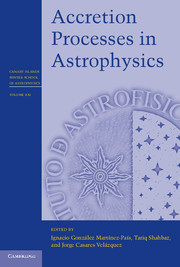Refine listing
Actions for selected content:
16950 results
7 - Asteroseismology of red giants
-
-
- Book:
- Asteroseismology
- Published online:
- 05 December 2013
- Print publication:
- 13 January 2014, pp 194-226
-
- Chapter
- Export citation
Frontmatter
-
- Book:
- Asteroseismology
- Published online:
- 05 December 2013
- Print publication:
- 13 January 2014, pp i-vi
-
- Chapter
- Export citation
List of contributors
-
- Book:
- Asteroseismology
- Published online:
- 05 December 2013
- Print publication:
- 13 January 2014, pp ix-x
-
- Chapter
- Export citation
4 - Studying stars through frequency inversions
-
-
- Book:
- Asteroseismology
- Published online:
- 05 December 2013
- Print publication:
- 13 January 2014, pp 87-122
-
- Chapter
- Export citation
1 - Sounding the solar cycle with helioseismology: Implications for asteroseismology
-
-
- Book:
- Asteroseismology
- Published online:
- 05 December 2013
- Print publication:
- 13 January 2014, pp 1-31
-
- Chapter
- Export citation
Preface
-
- Book:
- Asteroseismology
- Published online:
- 05 December 2013
- Print publication:
- 13 January 2014, pp xiii-xiv
-
- Chapter
- Export citation
Contents
-
- Book:
- Asteroseismology
- Published online:
- 05 December 2013
- Print publication:
- 13 January 2014, pp vii-viii
-
- Chapter
- Export citation
List of participants
-
- Book:
- Asteroseismology
- Published online:
- 05 December 2013
- Print publication:
- 13 January 2014, pp xi-xii
-
- Chapter
- Export citation
2 - Learning physics from the stars: It's all in the coefficients
-
-
- Book:
- Asteroseismology
- Published online:
- 05 December 2013
- Print publication:
- 13 January 2014, pp 32-59
-
- Chapter
- Export citation
3 - Solar-like oscillations: An observational perspective
-
-
- Book:
- Asteroseismology
- Published online:
- 05 December 2013
- Print publication:
- 13 January 2014, pp 60-86
-
- Chapter
- Export citation
Acknowledgments
-
- Book:
- Asteroseismology
- Published online:
- 05 December 2013
- Print publication:
- 13 January 2014, pp xv-xvi
-
- Chapter
- Export citation

Titan
- Interior, Surface, Atmosphere, and Space Environment
-
- Published online:
- 05 January 2014
- Print publication:
- 24 February 2014

Accretion Processes in Astrophysics
-
- Published online:
- 05 January 2014
- Print publication:
- 17 February 2014
Caput XIII - Inuestigatio inclinationis orbitae lunaris ad eclipticam cum eius variatione
-
- Book:
- Theoria motus lunae exhibens omnes eius inaequalitates
- Published online:
- 05 October 2014
- Print publication:
- 02 January 2014, pp 190-198
-
- Chapter
- Export citation
Caput XIV - Inuestigatio inaequalitatum Lunae ab eius inclinatione ad eclipticam oriundarum
-
- Book:
- Theoria motus lunae exhibens omnes eius inaequalitates
- Published online:
- 05 October 2014
- Print publication:
- 02 January 2014, pp 199-207
-
- Chapter
- Export citation
Caput I - De motu cǫrporis a viribus quibuscunque sollicitati
-
- Book:
- Theoria motus lunae exhibens omnes eius inaequalitates
- Published online:
- 05 October 2014
- Print publication:
- 02 January 2014, pp 9-16
-
- Chapter
- Export citation
INTRODUCTION
-
- Book:
- Theoria motus lunae exhibens omnes eius inaequalitates
- Published online:
- 05 October 2014
- Print publication:
- 02 January 2014, pp iii-vi
-
- Chapter
- Export citation
Caput XVII - Inuestigatio Elementorum motus Lunae
-
- Book:
- Theoria motus lunae exhibens omnes eius inaequalitates
- Published online:
- 05 October 2014
- Print publication:
- 02 January 2014, pp 231-265
-
- Chapter
- Export citation
Caput VIII - De Motu Apogei Lunae
-
- Book:
- Theoria motus lunae exhibens omnes eius inaequalitates
- Published online:
- 05 October 2014
- Print publication:
- 02 January 2014, pp 114-120
-
- Chapter
- Export citation
Frontmatter
-
- Book:
- Theoria motus lunae exhibens omnes eius inaequalitates
- Published online:
- 05 October 2014
- Print publication:
- 02 January 2014, pp i-ii
-
- Chapter
- Export citation
